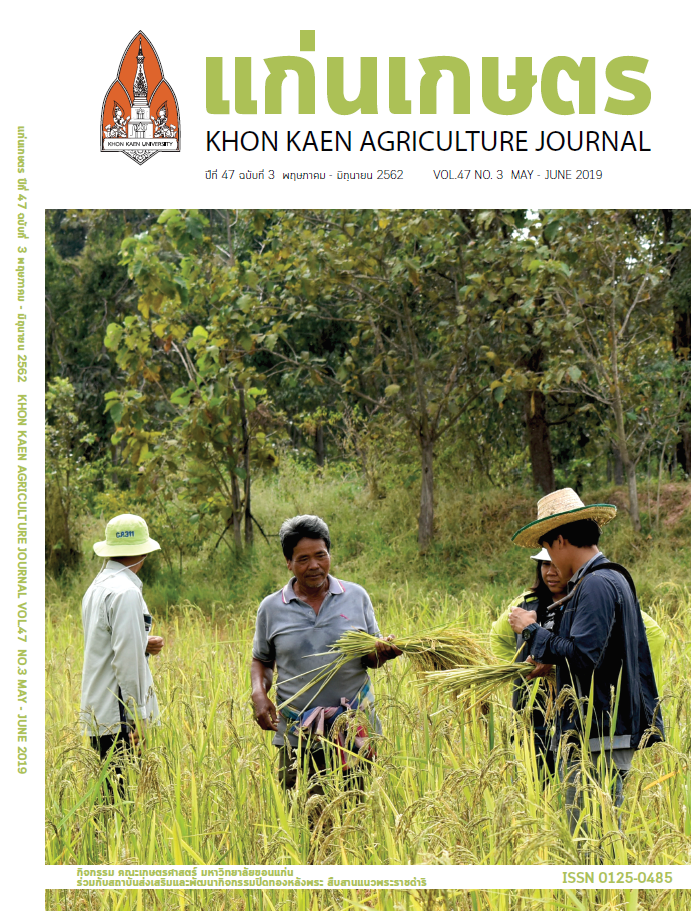ผลของการใช้กลีเซอรอลดิบที่มีเมทานอลต่ำต่อสมรรถภาพการผลิตและค่าทางเคมีในเลือด ของสุกรอนุบาล
Main Article Content
บทคัดย่อ
กลีเซอรอลดิบที่มีเมทานอลต่ำเป็นผลิตผลพลอยได้จากกระบวนการผลิตไบโอดีเซลสามารถถูกดูดซึมในทางเดินอาหารได้อย่างรวดเร็ว จึงสามารถใช้เป็นวัตถุดิบแหล่งพลังงานทางเลือกในอาหารสุกรอนุบาล และเนื่องจากมีรสหวานจึงคาดว่าจะสามารถกระตุ้นการกินอาหารของสุกรอนุบาลได้ โดยการทดลองทำการเลี้ยงสุกรอนุบาลลูกผสมสามสาย (แลนด์เรซ × ลาร์จไวท์ × ดูรอค) จำนวน 200 ตัว อายุ 3 สัปดาห์ น้ำหนักตัวประมาณ 6 กก. แบ่งสุกรออกเป็น 4 กลุ่ม กลุ่มละ 5 ซ้ำ ซ้ำละ 10 ตัว คละเพศ (เพศผู้ตอน 5 ตัว และเพศเมีย 5 ตัว) ให้ได้รับอาหารทดลองที่มีกลีเซอรอลดิบที่มีเมทานอลต่ำที่ระดับ 0, 2.5, 5 และ 7.5 % ตามลำดับ โดยกลีเซอรอลดิบที่ใช้ในการผสมอาหารมีกลีเซอรอล 84.6 % และเมทานอล 0.01 % ทำการเลี้ยงลูกสุกรในโรงเรือนปิดที่ควบคุมอุณหภูมิด้วยระบบระเหยไอน้ำเป็นระยะเวลา 6 สัปดาห์ (อายุ 4-9 สัปดาห์) ผลการศึกษาพบว่าสมรรถภาพการผลิตของลูกสุกรในทุกช่วงอายุแตกต่างกันอย่างไม่มีนัยสำคัญทางสถิติ (P>0.05) แต่พบว่าที่ช่วงอายุ 7-9 สัปดาห์ การใช้กลีเซอรอลดิบที่ระดับ 5 และ 7.5 % มีผลให้ความน่ากินของอาหารลดลง ส่งผลให้ปริมาณการกินได้ต่อตัวต่อวันของลูกสุกรลดลง ทำให้ระดับพลังงานที่ใช้ประโยชน์ได้ที่ได้รับต่อวันลดลง มีผลให้ปริมาณการกินได้ต่อตัวต่อวันและค่าเฉลี่ยของพลังงานที่ใช้ประโยชน์ได้ต่อวันที่สุกรอนุบาลกลุ่มดังกล่าวได้รับตลอดระยะเวลาการทดลอง (4-9 สัปดาห์) มีค่าลดต่ำลงอย่างมีนัยสำคัญทางสถิติ (P <0.05) ทำให้การเจริญเติบโตเฉลี่ยต่อวันลดลง แต่ประสิทธิภาพในการเปลี่ยนอาหารเป็นน้ำหนักตัวดีขึ้น ในด้านระดับกลูโคสและกลีเซอรอลในกระแสเลือดนั้น พบว่ามีความแตกต่างกันอย่างไม่มีนัยสำคัญทางสถิติในทุกกลุ่มทดลอง (P>0.05)
Article Details
เอกสารอ้างอิง
พจน์ ศรีบุญลือ, โสพิศ วงศ์คำ และ พัชรี บุญศิริ.2543. ตำราชีวเคมี. พิมพ์ครั ้งที่ 3. ภาควิชาเคมี คณะแพทยศาสตร์ มหาวิทยาลัยขอนแก่น, ขอนแก่น.
AOAC. 1990. Official Methods of Analyses, 15th edition. Association of Official Analytical Chemists. Arlington, VA.
Brambilla, S.and Hill, F. W. 1966. Comparison of neutral fat and free fatty acids in high lipid low carbohydrates diets for the growing chicken. J .Nutr. 88:84-92.
Carvalho, P. L. O., I. Moreira, E. N. Martins, L. M. Piano, J. B. Toledo, and C. L. C. Filho. 2012. Crude glycerine in diets for piglets. R. Bras. Zootec. 41: 1654-1661.
Groesbeck, C. N., L. J. McKinney, J. M. DeRouchey, M. D. Tokach, R. D. Goodband, S.S. Dritz, J. L. Nelssen, A. W. Duttlinger, A. C. Fahrenholz, and K. C. Behnke. 2008. Effect of crude glycerol on pellet mill production and nursery pig growth performance. J. Anim. Sci. 86: 2228-2236.
Hansen, C. F., A. Herenandez, B. P. Mullan, K. Moore, M. Trezona-Murry, R. H. King, and J. R. Pluske. 2009. A chemical analysis of samples of crude glycerol from the production of biodiesel in Australia, and the effects of feeding crude glycerol to growing-finishing pigs on performance, plasma metabolites and meat quality at slaughter. Anim. Prod. Sci. 49: 154-161.
Kerr, B. J., M. Honeyman, P. Lammers, and S. Hoyer. 2007. Feeding bioenergy coproducts to swine. Iowa State University Animal Industry Report 2007.
Kerr, B. J., T. E. Weber, W. A. Dozier III, and M. T. Kidd. 2009. Digestible and metabolizable energy content of crude glycerin originating from different sources in nursery pigs. J. Anim. Sci. 87: 4042-4049.
Kijora, C. and R. D. Kupsch. 1996. Evaluation of technical glycerols from “Biodiesel” production as a feed component infattening pigs. Fett/Lipid. 98: 240-245.
Kijora, C., H. Bergner, R. D. Kupsch, and L. Hageman. 1995. Glycerol as feed component in diets of fattening pigs. Arch. Anim. Nutr. 47: 345-360.
Lammers, P. J., M. Honeyman, B. Kerr, and T. E. Weber. 2007. Growth and performance of nursery pigs fed crude glycerol. Iowa State University Animal Industry Report 2007.
Lammers, P. J., M. Honeyman, K. Bregendahl, B. J. Kerr, T. E. Weber, W. Dozier, and M. Kidd. 2007. Energy value of crude glycerol fed to pigs. Iowa State University Animal Industry Report 2007.
Lammers, P. J., B. J. Kerr, T. E. Weber, W. A. Dozier III, M. T. Kidd, K. Bregendahl, and M. S. Honeyman. 2008. Digestible and metabolizable energy of crude glycerol for growing pigs. J. Anim. Sci. 86: 602-608.
Lin, E. C. C. 1977. Glycerol utilization and its regulation in mammals. Annu. Rev. Biochem. 46: 765-795.
Mourot, J., A. Aumaitre, A. Mounier, P. Peiniau, and A. C. Fracois. 1994. Nutritional and physiological effects of dietary glycerol in the growing pig. Consequences on fatty tissues and post mortem muscular parameters. Livest. Prod. Sci. 38: 237–244.
Schieck, S., L. Johnston, B. Kerr, S. Baidoo, and J. Shurson. 2010. Use of crude glycerol, a biodiesel co-product, in diets for lactating sows. Final report to Minnesota Pork Board 2009.
Sharma Y. C., B. Singh, and S. N. Upadhyay. 2008. Advancements in development and characterization of biodiesel: A review. Fuel.87: 2355–2373.
Sterk, A., P. Schlegel, A. J. Mul, M. UbbinkBlanksma, and E. M. A. M. Bruininx. 2009. Effect of sweeteners on individual feed intake characteristics and performance in group-housed weanling pigs. J. Anim. Sci. 86: 2990-2997.
Zijlstra, R. T., K. Menjivar, E. Lawrence, and E. Beltranena. 2009. The effect of feeding crude glycerol on growth performance and nutrient digestibility in weaned pigs. Can. J. Anim. Sci. 89: 85-89.


